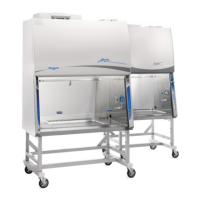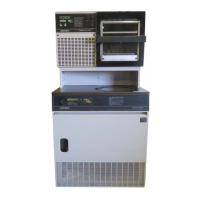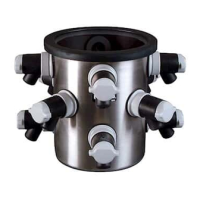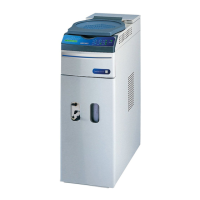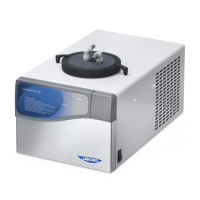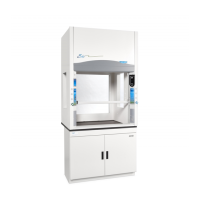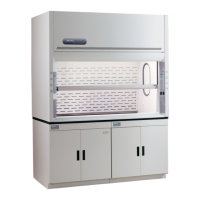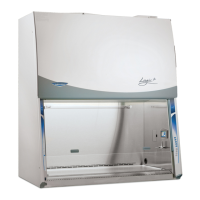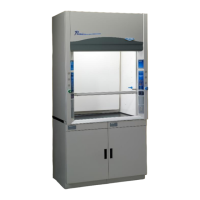Do you have a question about the Labconco Axiom C1 and is the answer not in the manual?
Guidance on manual usage and where to find technical information.
Lists items packaged with the biosafety cabinet product.
Guidelines for selecting an appropriate installation site away from disturbances.
Specifies minimum clearances needed around the product for service access.
Details power supply and circuit breaker specifications for the cabinet models.
Outlines requirements for connecting utility service lines like gas or water.
Specifies how to connect the cabinet to a building exhaust system for safe operation.
Explains symbols and formatting used to convey safety information in the manual.
Lists critical safety warnings applicable to operating and servicing the equipment.
Specific safety guidelines and warnings related to the biosafety cabinet's operation.
Procedures and tools required for safely unpacking the biosafety cabinet.
Step-by-step instructions for connecting the cabinet to the electrical power supply.
Detailed guide for connecting service lines, such as gas or water, to the cabinet.
Instructions for connecting the cabinet to the building's exhaust system for B-mode operation.
Optional procedure for installing a drain valve assembly for liquid removal.
Requirements and tests for certifying the biosafety cabinet for proper operation.
Defines laminar airflow and its role in capturing aerosols within the cabinet.
Explains how airflow at the front grille protects against aerosol escape.
Describes the function of front grille openings in establishing directional airflow.
Details the unique Chem-Zone feature for direct exhaust of specific work areas.
Explains the construction and efficiency of HEPA filters used in the biosafety cabinet.
Information on optional ULPA filters and their higher efficiency compared to HEPA filters.
Describes the cabinet's two motor/blower system and their ECM technology.
Details the optional UV lamp's function, wavelength, and maintenance recommendations.
Displays status information like filter life, blower status, and current time.
Explains how the LCD display enters sleep mode to conserve energy and extend life.
Overview of the biosafety cabinet's control keypad buttons and their functions.
How to access and navigate the main menu with its configuration, settings, and tools options.
Settings for audible tones, language, clock, and automatic sash operation modes.
Options for units of measure, security lock, data output rate, and UV parameters.
Instructions for using the interval (countdown) and elapsed (stopwatch) timers.
Explains the airflow alert system and common causes of activation.
Details various alarms like Power Loss, Sash Height, and Blower Failure.
Illustrates key features and components of the Axiom Type C1 biosafety cabinet.
Location and function of the system reset switch for the control board.
Detailed explanation of each button on the cabinet's keypad and its operation.
How to operate the counterbalanced sash and its safety interlock system.
Configuration and startup procedures for the cabinet's blower system.
How to control the cabinet's LED lighting, including automatic features.
Information on the cabinet's internal GFIC outlets and their power control.
Instructions for using the optional pass-thru for cords and cables.
Steps for safe and efficient work, including planning, startup, and wipe down.
Guidelines for safely loading and unloading items into and from the cabinet.
Best practices for aseptic technique and minimizing contamination during operation.
Procedures for purging airborne contaminants and safely shutting down the cabinet.
Essential safety measures to follow during maintenance activities on the cabinet.
A table outlining routine activities and their recommended frequencies (weekly, monthly, annually).
Procedure for resetting internal circuit breakers in case of an overcurrent situation.
Step-by-step guide for removing the center and wing work surfaces for maintenance.
Procedures for removing the drip tray and front grille for access.
Steps for removing the front panel and replacing LED lamps.
Guide for replacing the UV lamp and preparing the cabinet for storage.
Information on available telescoping and hydraulic lift base stands for the cabinet.
Details on optional accessories like IV Bar, Flat Work Surface, and Airflow Sensor.
Information on the optional BIBO exhaust HEPA filter for toxic particulates.
Details on the sash prop accessory for maintaining specific sash heights.
Troubleshooting steps for when the cabinet's blower and lights fail to operate.
Diagnosing issues with the blower not starting or lights not illuminating.
Troubleshooting UV light failure and airflow alert activation issues.
Addressing filter gauge readings and contamination in the work area.
Lists power consumption (Watts) for different catalog numbers.
Details motor type, voltage, amperage, and torque for the cabinet.
Specifies ambient temperature, humidity, and voltage fluctuation limits.
Guidance on manual usage and where to find technical information.
Lists items packaged with the biosafety cabinet product.
Guidelines for selecting an appropriate installation site away from disturbances.
Specifies minimum clearances needed around the product for service access.
Details power supply and circuit breaker specifications for the cabinet models.
Outlines requirements for connecting utility service lines like gas or water.
Specifies how to connect the cabinet to a building exhaust system for safe operation.
Explains symbols and formatting used to convey safety information in the manual.
Lists critical safety warnings applicable to operating and servicing the equipment.
Specific safety guidelines and warnings related to the biosafety cabinet's operation.
Procedures and tools required for safely unpacking the biosafety cabinet.
Step-by-step instructions for connecting the cabinet to the electrical power supply.
Detailed guide for connecting service lines, such as gas or water, to the cabinet.
Instructions for connecting the cabinet to the building's exhaust system for B-mode operation.
Optional procedure for installing a drain valve assembly for liquid removal.
Requirements and tests for certifying the biosafety cabinet for proper operation.
Defines laminar airflow and its role in capturing aerosols within the cabinet.
Explains how airflow at the front grille protects against aerosol escape.
Describes the function of front grille openings in establishing directional airflow.
Details the unique Chem-Zone feature for direct exhaust of specific work areas.
Explains the construction and efficiency of HEPA filters used in the biosafety cabinet.
Information on optional ULPA filters and their higher efficiency compared to HEPA filters.
Describes the cabinet's two motor/blower system and their ECM technology.
Details the optional UV lamp's function, wavelength, and maintenance recommendations.
Displays status information like filter life, blower status, and current time.
Explains how the LCD display enters sleep mode to conserve energy and extend life.
Overview of the biosafety cabinet's control keypad buttons and their functions.
How to access and navigate the main menu with its configuration, settings, and tools options.
Settings for audible tones, language, clock, and automatic sash operation modes.
Options for units of measure, security lock, data output rate, and UV parameters.
Instructions for using the interval (countdown) and elapsed (stopwatch) timers.
Explains the airflow alert system and common causes of activation.
Details various alarms like Power Loss, Sash Height, and Blower Failure.
Illustrates key features and components of the Axiom Type C1 biosafety cabinet.
Location and function of the system reset switch for the control board.
Detailed explanation of each button on the cabinet's keypad and its operation.
How to operate the counterbalanced sash and its safety interlock system.
Configuration and startup procedures for the cabinet's blower system.
How to control the cabinet's LED lighting, including automatic features.
Information on the cabinet's internal GFIC outlets and their power control.
Instructions for using the optional pass-thru for cords and cables.
Steps for safe and efficient work, including planning, startup, and wipe down.
Guidelines for safely loading and unloading items into and from the cabinet.
Best practices for aseptic technique and minimizing contamination during operation.
Procedures for purging airborne contaminants and safely shutting down the cabinet.
Essential safety measures to follow during maintenance activities on the cabinet.
A table outlining routine activities and their recommended frequencies (weekly, monthly, annually).
Procedure for resetting internal circuit breakers in case of an overcurrent situation.
Step-by-step guide for removing the center and wing work surfaces for maintenance.
Procedures for removing the drip tray and front grille for access.
Steps for removing the front panel and replacing LED lamps.
Guide for replacing the UV lamp and preparing the cabinet for storage.
Information on available telescoping and hydraulic lift base stands for the cabinet.
Details on optional accessories like IV Bar, Flat Work Surface, and Airflow Sensor.
Information on the optional BIBO exhaust HEPA filter for toxic particulates.
Details on the sash prop accessory for maintaining specific sash heights.
Troubleshooting steps for when the cabinet's blower and lights fail to operate.
Diagnosing issues with the blower not starting or lights not illuminating.
Troubleshooting UV light failure and airflow alert activation issues.
Addressing filter gauge readings and contamination in the work area.
Lists power consumption (Watts) for different catalog numbers.
Details motor type, voltage, amperage, and torque for the cabinet.
Specifies ambient temperature, humidity, and voltage fluctuation limits.
| Dimensions | Varies by model |
|---|---|
| Material | Stainless steel |
| Certification | NSF/ANSI 49 |
| Width (exterior) | 48 in (122 cm) |
| Depth (exterior) | 31.5 inches (80.0 cm) |
| Height (exterior) | 59.0 inches (149.9 cm) |
| Work Surface | Stainless steel |
| Width | 48 in (122 cm) |
| Depth | 30 in (76 cm) |
| Height | 60 in (152 cm) |
| Lighting | LED |
